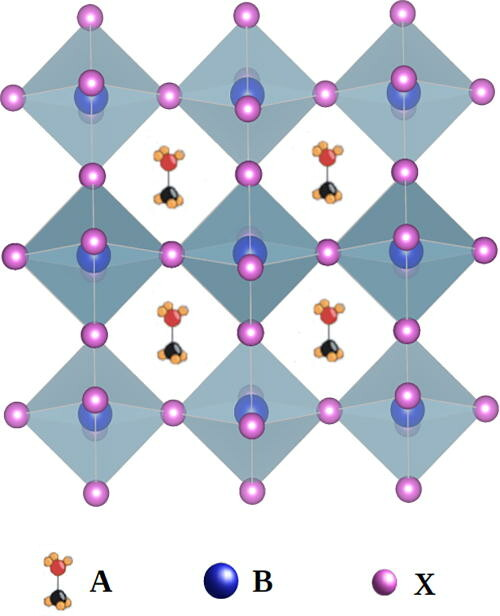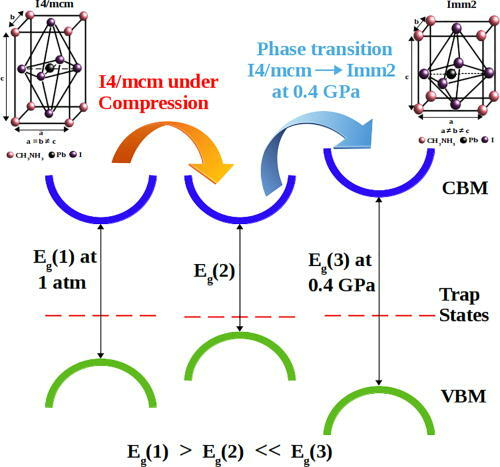The huge family of composites based on perovskites has sparked a lot of attention as a result of recent developments in materials science research. Perovskite is a substance with the same crystalline structure as the first perovskite crystal found, calcium titanium oxide. Perovskite has piqued the curiosity of material scientists because of its extensive availability in nature. Research in the journal by the American Institute of Physics (AIP) dives deep into the evolution of perovskite materials.
 Graphical visualization of general ABX3 perovskite structure with A representing organic cation, B is metallic cation and X represents halogen. Image Credit: Basavarajappa, M., Applied Physics Reviews
Graphical visualization of general ABX3 perovskite structure with A representing organic cation, B is metallic cation and X represents halogen. Image Credit: Basavarajappa, M., Applied Physics Reviews
Due to their low production cost and higher efficiency, perovskite-based photovoltaic cells with hybrid organic-inorganic metal halides as a light-collecting active material are regarded as prospective materials in the photovoltaic sector.
Power Generation Using Perovskites
Hybrid organic-inorganic perovskites (HOIPs) are a new class of perovskite materials with a wide range of unique optoelectronic characteristics that might be used in power generation that are both sustainable and environmentally friendly.
These materials might also be used to fine-tune structural, electrical, and optical characteristics in response to external stimuli such as temperature, pressure, and electric fields, which could be useful in types of energy materials.
Over the last decades, solar cells from hybrid organic-inorganic perovskite (HOIP) have significantly developed power conversion efficiency, surpassing 25.5 percent. HOIPs have been studied extensively in order to produce novel materials for photovoltaic modules, natural light-emitting diodes, and field-effect transistors.
The increased absorption coefficient, fully variable bandgap, and extended diffusion lengths of HOIPs distinguish them as exceptional photovoltaic cell materials for a variety of technological applications.
The material CaTiO3 and any configuration with the same ABX3 are referred to as perovskite.
The stability with those HOIP materials may be improved using various compositional technologies and systems, such as tweaking their characteristics by changing the organic or inorganic cations. Despite the fact that the inorganic component of the electronic band structure is the most important, the organic cation impacts the inorganic framework by reacting with the adjacent 12 halogens, which changes the optical and electrical characteristics.
These HOIPs have become the most attractive material for solar cells due to improved photovoltaic characteristics while maintaining structural integrity.
![Optical micrographs showing piezochromism in (EDBE)[CuCl4] perovskite.](https://www.azom.com/images/news/ImageForNews_57126_16355104745566147.png)
Optical micrographs showing piezochromism in (EDBE)[CuCl4] perovskite. Reproduced with permission from Jaffe et al., J. Am. Chem. Soc. 137, 1673–1678 (2015). Copyright 2015 American Chemical Society.
Evolutions in HOIPs materials
Hydrostatic pressure has been successfully used as a sensitive technique to control hybrid perovskites' photovoltaic characteristics and morphological phases in new investigations. Many studies have shown that the condition of the A-site ion significantly impacts diffusing lengths or carriers' lifetimes compared to those of highly pure single-crystal semiconductors.
It has been demonstrated that the crystalline structure of HOIPs material expresses itself under pressure through numerous structural phases that are normally unavailable due to temperature variations.
Pressure-induced processes such as lattice strain, phase transition, Jahn–Teller phenomenon, photochromism, Rashba-splitting, and others help to improve photovoltaic semiconductors. Extreme behavior in substances, such as metallization, increased or forced superconductivity, and magnetic structuring, can be improved by lattice compression.
HOIPs' electrical versatility has allowed them to be used in various applications, including LEDs and white-light phosphors. Although two-dimensional hybrid perovskites are used as solar absorbers with improved electrical characteristics, their three-dimensional counterparts have photovoltaic and optoelectronic uses.
The materials structures formed at these elevated pressures can be thought of as solids with expanded electronic bands that have enough orbital overlapping to allow charge carrier movement, resulting in a less deformable phase.
The systematic study of metallization in HOIPs under pressure to achieve improved excitonic transport capabilities as well as superior electrical properties like superconductivity is an interesting subject. In order to expose the enhancement of material qualities with pressure, a new subject called material pressure engineering may be researched, which integrates both breakthroughs in materials science and engineering ways to incorporate pressure for optimal use.

Illustration of increase in carrier lifetime with pressure induction in MAPbI3. The phase transition from I4/mcm tetragonal crystal structure at ambient pressure to Imm2 orthorhombic crystal structure at 0.4 GPa pressure is also represented. Image Credit: Basavarajappa, M., Applied Physics Reviews
There are various difficulties in the subject of pressure in HOIPs that can be studied in the coming years. The low pressure (or hydrostatic tensile pressure) in HOIPs, a hot new tool for tuning functional and structural features at the nanoscale, is among the main areas of interest.
The study of chaotic amorphous phase HOIPs at high pressure, which has received less attention than the crystalline phase, has also become a hot research area. As previously said, changing the organic portion of HOIPs is critical for increased system stability. Therefore, research into the structural transition of any organic material in HOIPs under high pressure is yet another intriguing area to pursue.
Another current difficulty in the area is designing and constructing HOIPs that exhibit desired changes at low pressure. That is because high-pressure analysis in HOIPs is another method of discovering novel materials; high-pressure application allows the material to be structurally transformed fully.
Reference:
Basavarajappa, M. (2021). Evolution of hybrid organic–inorganic perovskite materials under external pressure. Applied Physics Reviews Volume 8 Issue 4. Published Online: 25 October 2021. https://aip.scitation.org/doi/full/10.1063/5.0053128
Disclaimer: The views expressed here are those of the author expressed in their private capacity and do not necessarily represent the views of AZoM.com Limited T/A AZoNetwork the owner and operator of this website. This disclaimer forms part of the Terms and conditions of use of this website.